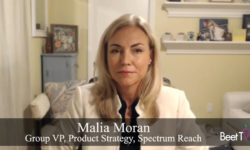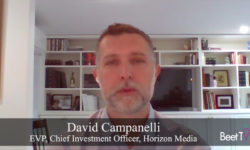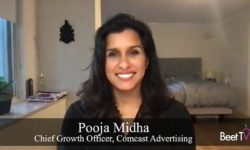In a media environment this complex, it seems like planners can earn their crust again.
With new viewing options supplanting linear, but coming with a host of fragmentation, agencies have a role in picking the right mix of capabilities and inventory value.
In this video interview with Beet.TV, Brad Stockton, Dentsu’s SVP of US national video innovation, does exactly that.
Accountability drive
Are you attending the @Digiday Business of TV Forum? Join dentsu’s SVP, National Video Innovation Brad Stockton, and Digiday’s Managing Editor @SaraJerde today at 2:45PM ET for a discussion about the future of identity in TV and streaming advertising: https://t.co/g6SgfpRK92 pic.twitter.com/pFB4Tx2QUO
— Dentsu USA (@dentsuUSA) November 1, 2021
“The great thing addressable brings to the table is to really hold that media more accountable to both reach and action,” Stockton says.
“We have all this data at our fingertips (but need to understand), across these walled gardens, across these partners, where are audiences showing up the most and where are they consuming that content?
“When you’re evaluating different ways to access connected TV, you have to really understand, well, who has the ability to serve an ad in which environment?”
FAST’s relative merits
Case in point – Stockton sees the merits of new free and ad-supported TV (FAST) services compared with broadcasters’ own.
“FAST channels – like a Tubi, a Xumo, a Pluto, their audiences are growing at exponential rates; people are leaning into these FAST channels,” he says.
“But those partners, they have a lot of scale against great content (but) how much registration data do they have?
“Not a knock on them. They have great content that people are coming to every single day. I think it’s (about) finding the right balance of how you want to activate across these different partners.”
He sees SSP platforms being used as good buying gateways for the likes of Pluto, Tubi and Xumo, whereas more direct deals might be necessary to place around content from the likes of NBC and CW.
What’s next for advertisers trying to target streamers? Tune into #AdvertisingWeek today at 10:30am ET with Brad Stockton, SVP, US National Video Innovation, and learn more about how regional buys impact today’s media: https://t.co/XdkeDv8ywo
— Dentsu USA (@dentsuUSA) October 18, 2021
Understanding the landscape
Therein lays the value agencies can provide once again – signposting the way through very different media platforms, very different types of inventory and very fragmented ways of accessing it.
“Fragmentation”. That’s the common word used to describe the connected TV environment, for all its undoubted benefits.
So Stockton hopes “interoperability and collaboration” will be the watch-words the industry heeds.
“We want to make sure we’re working with partners that have access to a lot of inventory, but also have really great backend data to allow us the highest level of fidelity when doing targeting,’ he says.
You’re watching “Arriving at Your Audience: Why Direct-to-Household Connectivity Is Critical for TV Advertisers” a Beet.TV Leadership Series presented by Blockgraph. For more videos from this series, please visit this page.
































